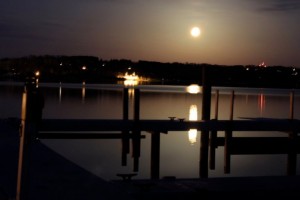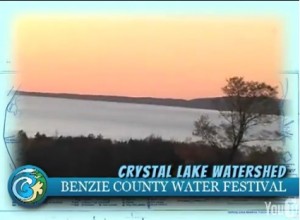Community Water Council holds first annual Benzie County Water Festival
By Aubrey Ann Parker
Sun contributor
Yesterday, March 22, was the 18th internationally recognized World Water Day, started by the United Nations as a way to educate and engage the masses to water pollution and scarcity problems around the globe.
In honor of this, last weekend the Benzie Community Water Council held its first annual Benzie County Water Festival, a celebration and education event. In August of 2006, the first Michigan Water Festival was hosted in the Straits of Mackinaw City, but the festival has since moved to Grand Rapids, Kalamazoo, Traverse City, and even the far northlands of Marquette.
This past weekend’s events kicked off Friday night with a showing of Waterlife—a beautifully shot documentary that focuses on specific environmental problems facing the Great Lakes—featured at the stunning, newly renovated Garden Theater of Frankfort. There were more than 90 people in attendance, with donations to the Friends of Betsie Bay, a local non-profit that promotes “a community in harmony with nature.”
 Karen Roberts of Elberta sponsored the film, which she first saw at the 2009 Traverse City Film Festival. Roberts attributed one scene in particular—in which a homeowner is mowing the riverbed that has been taken over by the invasive plant Phragmites, or “common reed”—as the major contributing factor for her membership in the FoBB.
Karen Roberts of Elberta sponsored the film, which she first saw at the 2009 Traverse City Film Festival. Roberts attributed one scene in particular—in which a homeowner is mowing the riverbed that has been taken over by the invasive plant Phragmites, or “common reed”—as the major contributing factor for her membership in the FoBB.
The fast-multiplying Phragmites is currently threatening several Lake Michigan waters, including the Betsie Bay. Phragmites can reach up to 10-feet tall and becomes rooted along a water’s edge, blocking light to other plants and creating a monoculture by inhabiting much of the growing area. A variety of methods are used to control Phragmites—including burning, cutting, digging, draining, dredging, mowing, mulching, and pulling—and the removal costs can be colossal. Saginaw Bay recently paid $75,000 to aerially release herbicide over 120 acres, while Beaver Island spent an estimated $17,000 on 27 acres in 2007.
After the film, the party moved to the Cabbage Shed as the sub-Prime Blues Band—one of the festival’s first supporting partners, consisting of an eclectic group of players—took the stage.
Although concert attendees closed down the Elberta bar, many trickled in early Saturday morning, ready for the day’s full lineup of events.
 “Get your refillable water bottles,” crooned Benzie Central freshman Majida Halaweh, pacing the Frankfort-Elberta Elementary School hallways, peddling BPA-free water bottles imprinted with husky paw prints.
“Get your refillable water bottles,” crooned Benzie Central freshman Majida Halaweh, pacing the Frankfort-Elberta Elementary School hallways, peddling BPA-free water bottles imprinted with husky paw prints.
Also meandering the halls was Kirby, a local singer and songwriter, touting his guitar and tooting his harmonica. The walls of the school were lined with drawings of baby seals and sailboats—some adorned with blue and red “Best of Show” ribbons—from Connie McLaren’s students at Crystal Lake Elementary.
Halaweh’s cohort, Bailey Barnes, was seated at one of a dozen tables, each housing a display from local, water-related organizations. Barnes’ father, Jim—owner of Traverse City-based Eco-Building Supplies, one of the festival’s sponsors—was across the hall demonstrating a low-flow flush toilet, while Liz Padalino gripped her Higher Grounds Coffee-filled mug and explained the difference between native and invasive Phragmites species to an onlooker of her Cooperative Weed Management display.
Filtering down to the gymnasium, festival attendees were welcomed by BCWC’s co-chair, Josh Stoltz, who introduced the first speaker.
“When I was growing up, Derek Bailey was one of my heroes,” 33-year-old Stoltz said of 38-year-old Bailey, now tribal chairman for the Grand Traverse Band of Ottawa and Chippewa Indians. “I had a photo of him in my notebook, because he was a basketball star from St. Francis.”
Bailey gave the audience of 50 a summary of the tribe’s unique position as a sovereign nation to litigate on behalf of all those who are interested in keeping the Asian carp out of the Great Lakes. As a sovereign nation, the Band signs treaties with the U.S. government directly, and so its rights are placed bureaucratically above those of individual states—and, Bailey said, this could be the key to winning the case to close the Chicago locks.
According to Bailey, the revenue from ships passing through the locks is on the scale of millions of dollars, but the revenue that could be lost if Asian carp infest Lake Michigan would be on the scale of billions of dollars.
Bailey also said that—although he hasn’t yet been invited to play basketball in the White House, despite being appointed to the American Indian Education Advisory Council by the Obama Administration—he thinks he could “post up” the president.
During a lunch break, festival attendees were invited to again check out the displays that lined the hallway, as well as to dine in the school’s cafeteria. BCWC board member Suz McLaughlin and her slew of volunteers were selling homemade cookies and three varieties of locally sourced, heartwarming soups: Mediterranean chicken, potato chowder with bacon, and black bean citrus with sour cream and salsa.
Meanwhile, Marlene Wood-Zylstra of the Benzie County Recyclers—dressed head-to-toe in a “Green Fairy” costume—had multiple interactive games, puzzles, and exhibits for children and adults alike to explore water use, reuse, and pollution. Nearly 25 kids chose to continue the afternoon playing in the multipurpose room with Wood-Zylstra or to participate in a harmonica workshop with Kirby, while the adults filed back into the gymnasium for the next speaker.
Rob Karner, a watershed biologist and biology teacher at The Leelanau School, took the stage to speak on the importance of native plants.
“My title is watershed biologist,” said Karner, who has spent the last 15 years helping residents of the Glen Lake shoreline to reduce the impact of their lawns. “But really I’m more of a waterfront psychologist.”
Karner’s lecture prompted a great Q&A period in which residents of Lake Michigan, Platte Lake, Crystal Lake, and Bear Lake wanted more information on what they could do to create a buffering recharge zone for their lawns.
Some simple solutions:
• Replace patches of your Kentucky Blue Grass with native, long-rooted plants that help to filter runoff—leave only a patch of grass for playing yard games like bocce or croquet.
• Retain as many trees and shrubs as possible. Not only do their long-root systems protect the watershed, but they also serve as animal habitat and natural privacy—enjoy more visits from Bambi and less from Home Improvement’s Wilson.
• Take out your break wall, and cut back on your use of fertilizers—the more natural a landscape is, the better.
Following the theme of reducing a household’s impact on local water, Valerie Strassberg—a water resource engineer and international water-energy educator—made the trek up from Ann Arbor to do a workshop on greywater systems.
Strassberg gave a lively introduction to the relationship between water and energy, in which she invited Kirby to try to lift 10 milk gallons full of water—80 pounds in total.
“Each gallon of water weighs eight pounds,” Strassberg said. “The average American uses 98 gallons of water per day, which equals 784 pounds…can you imagine if we had to carry the water we used each day?”
Instead, water is readily available from our tap, Strassberg went on, pumped there by our public utility or home well. Strassberg informed the audience that they could reduce their households’ water usage—and slash their monthly water bill—by retrofitting a greywater system.
Greywater systems take water that would typically go to the city’s wastewater facility or your home’s septic tank and divert it for irrigating your lawn or garden. Greywater is sanitary for irrigation (not for drinking) because it is sourced from bathroom sinks, showers, bathtubs, and washing machines that have minimal pollutants. (Black water, Strassber noted, is water from dishwashers, kitchen sinks, and toilets that require a sanitation process to kill bacteria.)
Tying in nicely with the topic of home-water conservation, the Benzie Conservation District—one of the Water Festival’s main sponsors—held a rain garden workshop that followed Strassberg’s greywater workshop. The BCD’s Carol Navarro began with a brief introduction to rain gardens, which are a way to remediate the runoff from roofs and parking lots that would typically end up in storm sewers.
A rain garden consists of long-rooted native plants that are grown in the lowest point of a yard, with surface water runoff directed towards that low point.
“Rain gardens slow water down,” said Carolyn Thayer—a landscape designer and owner of Designs in Bloom, and the president of Plant It Wild—who last year designed the rain gardens for the new LEED-certified Gateway Housing Project development on Forest Avenue in Frankfort. Thayer gave an overview of the project, which she designed to capture all of the runoff from the housing development’s roofs.
More than 50 community members were in attendance—many coming straight from Grow Benzie’s hoop house workshop, taking place the same day, just up the road in Benzonia—to learn the basics of rain garden design and implementation.
In the mid-afternoon, the Water Festival switched venues, back to the Garden Theater.
Cyndi Roper—the state director of Clean Water Action—was the first speaker at the Garden, having traveled up from Lansing. Roper has played a leadership role in numerous successful water policy, environmental health, and waste issues in Michigan since 1995, and she has served on the U.S. Environmental Protection Agency’s National Drinking Water Advisory Council. She came highly recommended to the BCWC by Benzie County’s own water warrior, attorney Jim Olson.
Following Roper, Hans VanSumeren, the director of NMC’s new Water Studies Institute—the first program in the nation to award an Associate’s Degree in water studies—and Tom Kelly, executive director of the Inland Seas Education Association and captain of the Schoolship, spearheaded a discussion on water-related education in the Great Lakes region.
Kelly and the Schoolship have hosted nearly 100,000 elementary, middle school, and high school students in the 20 years since the founding of Inland Seas. Since the WRI program began in September of 2010, VanSumeren has 20 college students—ranging in age from 17 to 54—enrolled in water-related studies.
Both men gave examples of the hands-on learning experiences that each program provides, with coursework that includes studying invasive species, monitoring pollution and climate data, and examining environmental consequences of removing three old dams on the Boardman River.
During both Roper’s lecture and the water education panel, festival goers were invited to step outside for a bite to eat, as the Benzie SEEDS program offered fresh, homemade pizza right outside the Garden’s doors.
A short intermission allowed the crowd to nearly triple, as more than 130 people, including our community’s tiniest tots and most age-wizened elders, piled in to see the night’s closing act.
Northern Michigan’s favorite dynamic duo, Seth Bernard and “Daisy” May Erlewine— the founding father and mother of the folk music explosion that has swept Northern Michigan over the past decade—are local singers, songwriters, and harmonizing musicians with a lot of soul. The pair took the stage with friend and fellow musician, drummer Mike Shimmin.
“From what I understand, they say the Promised Land is on the banks of the River Jordan,” Erlewine sang the opening lyrics to the concert, resonating with Bernard’s guitar.
Passionate about their community and the natural world we’re all connected to, the couple has been an intricate part of each Water Festival that has taken place in Michigan—from the first one at the Straits of Mackinaw City back in 2006 to Benzie County’s own, five years later, this past weekend.
Bernard and Erlewine, whose message of positive change and collaboration was infectious, played two sets, each chock full of the pair’s water-related songs from “Big Momma Brown,” a song about fishing, to “Wash Over Me,” a haunting a capella number, to finish by dancing up the aisles, guitars in hand, singing, “I’m going to join my local watershed council…down by the riverside…and I ain’t gonna study war no more.”
By the end of the day, the Benzie Community Water Council had more than 75 people sign up to become a watershed council member, and a number of people were wearing buttons declaring, “I signed the Water Pledge,” a personal promise to use less water—including the musicians, who encouraged the audience to pass on to others the water facts that M.C. Stoltz had been impressing upon the masses all day.
“It takes 1,500 gallons of water to grow enough cotton for just one pair of jeans,” Stoltz had said. “And a quarter of a gallon of gas to drive just one mile using petroleum-based fuels…more than 450 gallons to drive one mile using soy bean-based biofuel.”
The Cabbage Shed hosted an after-glow party, featuring one of Bernard and Erlewine’s many side projects, Airborne or Aquatic, which incorporated three additional musicians projecting funky blues from their guitars.
Also well-attended were Sunday morning’s water-related church service with Pastor Rick at Frankfort’s Trinity Lutheran Church and Sunday afternoon’s fundraiser for the Friends of the Benzie Bus at the Cabbage Shed, in which Benzie County’s own Song of the Lakes performed a benefit concert.
Song of the Lakes—who have been pleasing crowds with sea-faring tunes, Irish jigs, sultry Brazilian melodies, and bittersweet ballads since the early 1980s—continue to be one of Northern Michigan’s most sought-after musical groups, and the BCWC was honored that they chose to partner with us and close out the first annual Benzie County Water Festival.
Stay tuned for more events, as 100 percent of the proceeds from last weekend’s festival are being invested in future water-related community events. The BCWC hopes to have a lasting and sustainable presence in Northern Michigan. Go to www.water-festival.org for promoted events happening every month in Benzie County.
Aubrey Ann Parker is a northern Michigan native and graduate of both Kalamazoo College and the University of Michigan. She is an editor, reporter, and data analyst for Circle of Blue, a Traverse City-based organization reporting the global freshwater crisis.












